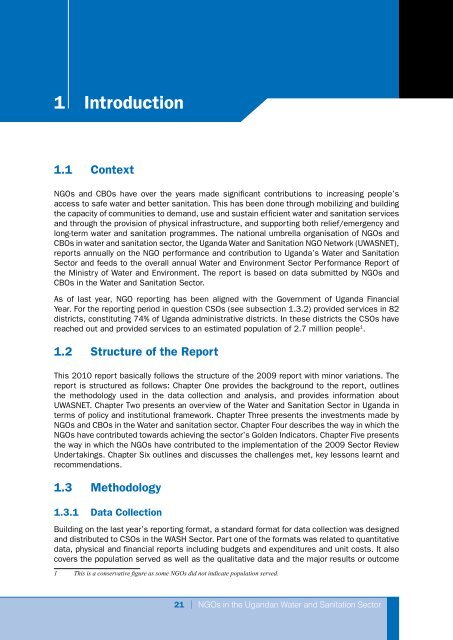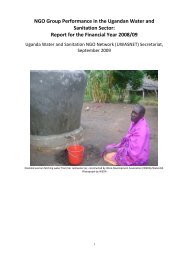Performance Report for FY 2009/10 - UWASNET
Performance Report for FY 2009/10 - UWASNET
Performance Report for FY 2009/10 - UWASNET
You also want an ePaper? Increase the reach of your titles
YUMPU automatically turns print PDFs into web optimized ePapers that Google loves.
1 Introduction<br />
1.1 Context<br />
<strong>Per<strong>for</strong>mance</strong> <strong>Report</strong> <strong>for</strong> <strong>FY</strong> <strong>2009</strong>/<strong>10</strong><br />
NGOs and CBOs have over the years made significant contributions to increasing people’s<br />
access to safe water and better sanitation. This has been done through mobilizing and building<br />
the capacity of communities to demand, use and sustain efficient water and sanitation services<br />
and through the provision of physical infrastructure, and supporting both relief/emergency and<br />
long-term water and sanitation programmes. The national umbrella organisation of NGOs and<br />
CBOs in water and sanitation sector, the Uganda Water and Sanitation NGO Network (<strong>UWASNET</strong>),<br />
reports annually on the NGO per<strong>for</strong>mance and contribution to Uganda’s Water and Sanitation<br />
Sector and feeds to the overall annual Water and Environment Sector <strong>Per<strong>for</strong>mance</strong> <strong>Report</strong> of<br />
the Ministry of Water and Environment. The report is based on data submitted by NGOs and<br />
CBOs in the Water and Sanitation Sector.<br />
As of last year, NGO reporting has been aligned with the Government of Uganda Financial<br />
Year. For the reporting period in question CSOs (see subsection 1.3.2) provided services in 82<br />
districts, constituting 74% of Uganda administrative districts. In these districts the CSOs have<br />
reached out and provided services to an estimated population of 2.7 million people 1 .<br />
1.2 Structure of the <strong>Report</strong><br />
This 20<strong>10</strong> report basically follows the structure of the <strong>2009</strong> report with minor variations. The<br />
report is structured as follows: Chapter One provides the background to the report, outlines<br />
the methodology used in the data collection and analysis, and provides in<strong>for</strong>mation about<br />
<strong>UWASNET</strong>. Chapter Two presents an overview of the Water and Sanitation Sector in Uganda in<br />
terms of policy and institutional framework. Chapter Three presents the investments made by<br />
NGOs and CBOs in the Water and sanitation sector. Chapter Four describes the way in which the<br />
NGOs have contributed towards achieving the sector’s Golden Indicators. Chapter Five presents<br />
the way in which the NGOs have contributed to the implementation of the <strong>2009</strong> Sector Review<br />
Undertakings. Chapter Six outlines and discusses the challenges met, key lessons learnt and<br />
recommendations.<br />
1.3 Methodology<br />
1.3.1 Data Collection<br />
Building on the last year’s reporting <strong>for</strong>mat, a standard <strong>for</strong>mat <strong>for</strong> data collection was designed<br />
and distributed to CSOs in the WASH Sector. Part one of the <strong>for</strong>mats was related to quantitative<br />
data, physical and financial reports including budgets and expenditures and unit costs. It also<br />
covers the population served as well as the qualitative data and the major results or outcome<br />
1 This is a conservative figure as some NGOs did not indicate population served.<br />
21 | NGOs in the Ugandan Water and Sanitation Sector



